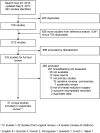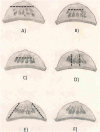The impact of breast reduction surgery on breastfeeding: Systematic review of observational studies
- PMID: 29049351
- PMCID: PMC5648284
- DOI: 10.1371/journal.pone.0186591
The impact of breast reduction surgery on breastfeeding: Systematic review of observational studies
Abstract
Background: Almost half a million breast reduction surgeries are performed internationally each year, yet it is unclear how this type of surgery impacts breastfeeding. This is particularly important given the benefits of breastfeeding.
Objectives: To determine if breast reduction surgery impacts breastfeeding success and whether different surgical techniques differentially impact breast feeding success.
Methods: Databases were searched up to September 5, 2017. Studies were included if they reported the number of women successful at breastfeeding or lactation after breast reduction surgery, and if they reported either the total number of women who had children following breast reduction surgery, or the total number of women who attempted to breastfeed following surgery.
Results: Of 1,212 studies, 51 studies met the inclusion criteria; they were located worldwide and had 31 distinct breast reduction techniques. The percentage of breastfeeding success among studies was highly variable. However, when analyzed by the preservation of the column of parenchyma from the nipple areola complex to the chest wall (subareolar parenchyma), a clear pattern emerged. The median breastfeeding success was 4% (interquartile range (IQR) 0-38%) for techniques with no preservation, compared to 75% (IQR 37-100%) for techniques with partial preservation and 100% (IQR 75-100%) for techniques with full preservation.
Conclusions: Techniques that preserve the column of subareolar parenchyma appear to have a greater likelihood of successful breastfeeding. The preservation of the column of subareolar parenchyma should be disclosed to women prior to surgery. Guidelines on the best breast reduction techniques to be used in women of child bearing years may be advantageous to ensure women have the greatest potential for successful breastfeeding after breast reduction surgery.
Conflict of interest statement
Figures





References
-
- Eldelman AI, Schandler RJ. American Academy of Pediatrics policy statement: breastfeeding and the use of human milk. Pediatrics. 2012;129: e827–841. - PubMed
-
- U.S. Department of Health and Human Services. The Surgeon General’s Call to Action to Support Breastfeeding. Washington: U.S. Department of Health and Human Services, Office of the Surgeon General; 2011. - PubMed
-
- World Health Organization. Breastfeeding. http://www.who.int/topics/breastfeeding/en/. Cited 22 Dec 2015.
-
- World Health Organization. Breastfeeding: Global Targets 2025. http://www.who.int/nutrition/global-target-2025/en/. Cited 22 Dec 2015.
-
- EU Project on Promotion of Breastfeeding in Europe. Protection, promotion and support of breastfeeding in Europe: a blueprint for action (revised). European Commission, Directorate Public Health and Risk Assessment, Luxembourg, 2008. http://ec.europa.eu/health/ph_projects/2004/action3/action3_2004_18_en.p...
Publication types
MeSH terms
LinkOut - more resources
Full Text Sources
Other Literature Sources
Medical
Molecular Biology Databases
Miscellaneous

